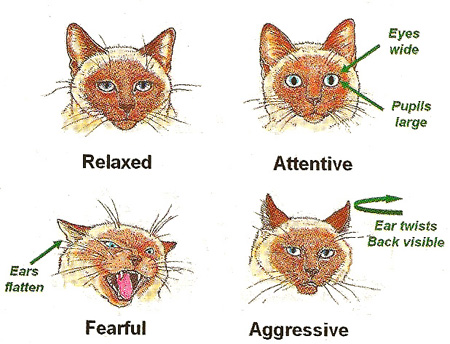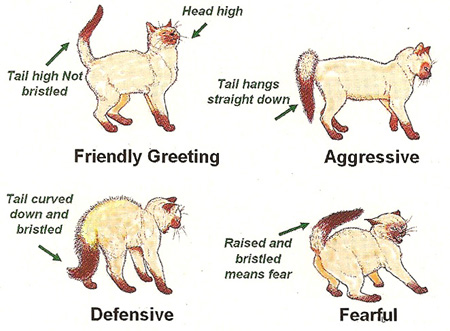Health Topics
Cat Body Language
(This article was originally published in the Fall 2008 Issue of Cat Basics and is reproduced here with the permission of the publisher.)
Reading the eyes, ears and tail.
The wild ancestors of dogs were social and cooperative hunters who needed an extensive form of language and communication to coordinate their activities. The wild ancestors of cats were solitary hunters who would normally go for lengthy periods without face-to-face encounters with others of their kind.
This means that cats really do not need a complex communication system with lots of nuances and signals. When cats do meet, it is still important that they understand the signals of other felines, and it is important for humans to learn to interpret what their cat is trying to say.
Although cats do make sounds and use them to communicate, their body language is much more sophisticated and carries more information. Many of the visible signals that a cat uses are not voluntary, but rather are due to physical effects that result when the cat expresses emotional states such as being relaxed, alert, friendly, tolerant, fearful, apprehensive, defensive or aggressive. Much of the body language of cats simply is the result of their nervous system responding to changes in stress levels and sending messages that change a cat's posture and behaviour. That means that the majority of cat body language signals are universal and don't depend on the cat's personal history or learning experiences.
The most easily seen and interpreted cat signals are given by their ears and tail, although looking at a cat's eyes and body posture will provide additional information as to how excited or stressed he is.

Look Into His Eyes
- Eyes that are half-drooped signal feelings of trust and relaxation.
- Eyes that widen into circles show a shift from a relaxed mood into one where he is alert and attentive.
- Staring, with wide open eyes, represents a threat (this can be said for both cats and dogs).
- Blinking is a reassuring signal that breaks the threatening stare.
- A cat's pupils (the black hole in the coloured portion of their eyes) will tell you how aroused a cat is. As his arousal level increases, his pupils grow larger and wider. The bigger the pupils, the more likely a cat is to take action of some sort.
Ear Direction
Because a cat's ears are pricked and stick up above his head when he is relaxed, they are easily seen and changes in ear position provide good signals of fluctuations in your cat's mood. Cats have around 30 muscles that allow them to move their ears in many ways.
- A calm attentive cat will have his ears up.
- If something catches his attention, a cat will angle his ears slightly forward in the direction of the interesting event.
- A frightened cat will tend to flatten its ears down against its head.
- The first sign of rising tension in a cat is when his ears flatten out to the side giving the impression of airplane wings.
- The ears of an aggressive cat will rotate so that the inside surfaces are toward the side and the backs of the ears are now visible. In some of the larger wild members of the cat family, the backs of their ears are marked with distinctive patterns that makes any rotation of their ears more conspicuous and allows others to know that they are annoyed. Some wild cat species have tufts at the ends of their ears that also help to make the ear's positions and rotations more visible from a distance.
Tail Talk
Tails (combined with body posture) are also easily read aspects of the cat's body language. Although both dogs and cats wag their tails, their meanings are actually opposite.
FOR DOGS, the broad wagging of its tail is what we might call a distance-reducing signal that invites another individual to come close in a friendly manner.
FOR CATS, however, tail swinging is a distance-increasing signal that tells the observer to go away and indicates some form of emotional conflict or tension. A broad swinging motion, which may actually thump the floor as it increases in speed and arc size, is the clear signal for aggression in a cat.

Tail position:The way the tail is carried is also important. When you see a cat with his tail held straight up, or curved somewhat over its back, and not bristling or bushed out, you are observing one of the friendliest signs that the species ever offers - especially if the cat's head is held high. The high tail allows another friendly cat to investigate the exposed region at its base. Cats have scent glands around their anal region that provide pheromones that can identify the individual to anyone who catches the familiar odour. Raising the tail is much like offering someone your passport or driver's license to verify your identity.
Bristling:Bristling in the tail is much like dilation of the pupils of the eyes in that it shows arousal or stress. When a bristled tail is held straight down, this is an aggressive signal that is often seen when cats are about to pounce on something, signaling that they are annoyed or challenging another individual. If the bristled tail is held down but curves up at the tip, the cat is feeling defensive. As the cat becomes more fearful, the bristled tail will rise until it reaches that familiar "Halloween cat" vertical position. Reading the height of a bristled tail will tell you just how worried or frightened the cat is. Although the range of communication in cats is somewhat restricted, it does communicate a lot about what the cat is feeling and what he is intending to do. Thus if your child is playing with Miss Kitty and her tail is now starting to lash back and forth, it is a good idea to call your child away and give the cat a break. If you don't give your cat some space, you may soon need a trip to the medicine cabinet for bandages and peroxide!

